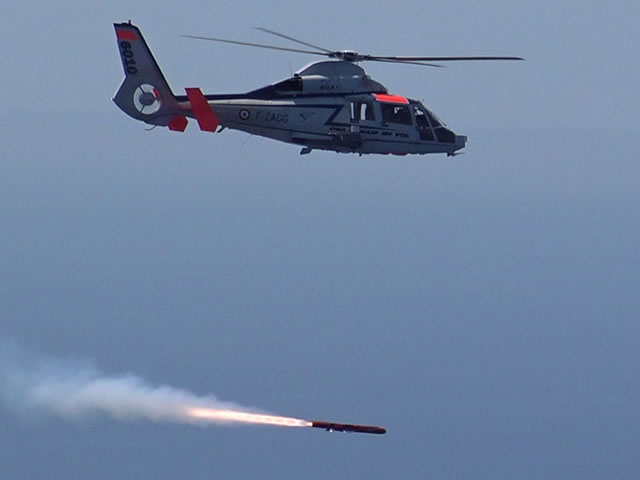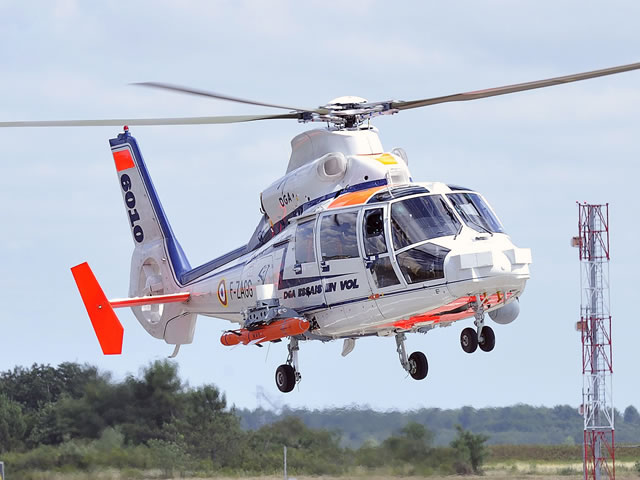|
|
|||
| a | |||
|
Naval Defence Industry News - France, UK
|
|||
|
|
|||
|
Successful First Test Firing for MBDA Sea Venom / ANL Anti-ship Missile
|
|||
| French Defence Procurement Agency (DGA) and MBDA teams successfully completed the first launch of the Antinavire Léger (ANL / Sea Venom ) missile on 21 June 2017 on the Mediterranean site of the DGA Missile Testing Center. The test was conducted from the DGA's Panther test helicopter. | |||
|
|
|||
 Sea Venom ANL first firing. Picture: MBDA Sea Venom ANL first firing. Picture: MBDA |
|||
|
|
|||
| ANL / Sea Venom is a high subsonic, sea skimming missile with a range of 20 Km designed for high lethal effect on littoral units (such as FACs and corvettes). The missile is effective against land based coastal targets as well. It is capable of several attack modes including "pop up / top attack". In this program, Sagem provides the IR seeker, Roxel the engine (while the booster is the same as on the Brimstone missile), Thales the radio altimeter and Eurenco the warhead. MBDA is developing the Sea Venom / ANL to meet the requirements of the British and French navies for a future helicopter-launched anti-ship missile. Weighing around 100kg, this missile will replace two other anti-ship missiles within the MBDA product portfolio. Sea Skua is used on the UK Royal Navy’s Lynx and on the Sea King, Lynx and AB212 helicopters of seven other countries, including the navies of Germany, Brazil, Malaysia, Kuwait, Turkey and South Korea. The AS15TT is used on the Panther helicopter operated by Middle Eastern forces. FASGW(H)/ANL will equip the Royal Navy’s AW159 Lynx Wildcat helicopters and the French Navy’s militarized H160 helicopters (HIL program for Hélicoptère Interarmées Léger or Light Joint Helicopter program). In addition, Navy Recognition learned recently that MBDA is working on a surface launched variant of the ANL / Sea Venom. |
|
|
|||
 MBDA Sea Venom ANL missile fitted on DGA's test helicopter. File Picture: DGA MBDA Sea Venom ANL missile fitted on DGA's test helicopter. File Picture: DGA |
|||
|
|
|||
| Suitable for both blue water and cluttered littoral operations, FASGW(H)/ANL represents a major advance on the generation of missiles which it will replace from a technological standpoint. This new system provides very precise effects against a wide range of threats even in complex environments thus satisfying a recognised and common future need. A high speed two-way data-link communicates the images, “seen” by the missile’s seeker, to the operator. Therefore, in addition to initiating an autonomous engagement, the operator can also monitor the action or even remain in control of the missile throughout the full duration of its flight. | |||
|
|
|||
 Sea Venom ANL first firing. Picture: MBDA Sea Venom ANL first firing. Picture: MBDA |
|||
|
|
|||
| Update: Frank Bastart, head of the Sea Venom/ANL programme at MBDA, said: “The missile trial was a complete success, and is a proud moment for the company and all those involved in the project. When it enters service Sea Venom/ANL will provide a major increase in capability to the French and UK armed forces.” Paul Goodwin, deputy head of the Sea Venom project, added: “Although a first firing this was in no way a cautious one. The system was pushed to the very edge of its range capability – a bold step showing our confidence in the design maturity and making success all the more sweet. The next step is to exercise the systems’ operator-in-the-loop capabilities.” |
|||










